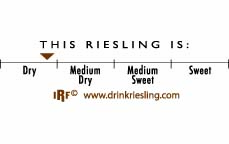Drink Riesling all Summer: How to Tell How Sweet It Is (and Why You Shouldn’t Sweat Sweetness Anyway)
As I learned at the Riesling Rendezvous this week, Riesling is moving and shaking (or should I say swirling) in some amazing up-and-coming regions and styles. I already loved this grape in all its guises. Now, after tasting so many great, new-to-me Rieslings, and re-connecting with old favorites, I am reminded that my sweetheart summer sip is really a lifelong love affair. Are you ready to spice up your summer with a cool Riesling romance? If you’re like me and a lot of other sommeliers, it just might turn out to be epic.

[jwplayer player=”1″ mediaid=”30369″]
Summer is the perfect season to embrace Riesling in all its juicy, refreshing glory. Why? Because it’s the vinous version of the cooling quaffs you’re already drinking: tangy fruited wheat beers, Margaritas, Mojitos, Mai Tais. Riesling even has the same flavor range–fruits from citrus to tropical; mouthwatering acidity; in many versions heady aromatics mimicking agave, mint, and flowers; and, depending on where it’s grown and the winemaking style, some sweetness.
I know: your excuse for not giving Riesling a serious try so far is the presumed sweetness, and I get it. In the 1970s consumers came to associate the traditional flute-shaped bottle with the sweet and simple Blue Nun Liebfraumilch (which wasn’t even a varietal Riesling). It’s time to fast-forward to today, because the flute bottle is rocking Rieslings of every style, with quality versions of enticing complexity starting at around ten bucks. Here’s how to get a handle on the styles, and what to expect from them.
Dry versus Sweet – Keep in mind, both dry and sweet are on a continuum. Dry can mean bone-dry and tingly-tart like a squeeze of lemon, to juicy but still tangy like an orange or tangerine. Sweet can range from ripe-sweet, like a peak-season peach, to nectar-sweet like peach liqueur, to syrupy-sweet like peach jam. The International Riesling Foundation’s “taste profile” scale was created to indicate the level of sweetness on wine labels for its member wineries. Here’s more label low-down to help you pick the perfect Riesling for your taste.
Dry – If it says “dry” on the label you can bank on that, but consider comparatively tasting two wines along the dry continuum–bone-dry to juicy-dry as described above–to see the difference. The historic home of the bone-dry style is France’s Alsace region, and the benchmark bottling from Trimbach is easy to find. Austria, and Australia’s Clare Valley, also specialize in the style. From the U.S., Trefethen and Smith-Madrone are two of my favorites. For juicy-dry options, look to Washington state, where you can’t do better for the price than Chateau Ste. Michelle Dry Riesling. Other highlights from the Riesling Rendezvous opened my eyes to a raft of new and delicious offerings from Canada, Oregon, Washington State, Michigan and Idaho.
How Sweet It Is – Germany is the historic home of Rieslings spanning the sweetness continuum, and the classic label designations can help guide you: ripe-sweet Kabinett, nectar-sweet Spatlese and Auslese, and the syrupy-sweet Beerenauslese dessert style. In Alsace, the label designations Selection de Grains Nobles and Vendange Tardive typically indicate a syrupy-sweet dessert style. The back label above shows the taste profile scale in action, a handy thing to look for when scoping out the Riesling section of your wine shop, which you WILL be doing, right? Last, and importantly:
Don’t Sweat Sweet! There are some very good reasons not to worry about sweetness. First, in quality Rieslings, the acidity level balances the sweetness to create a sensation of juicy-fresh liveliness on the palate like fresh fruit, or, like that Mojito or Margarita that’s juiced with citrus to counter the sugar. Second, since the path to dryness for a wine is fermentation of the ripe grapes’ sugar, residual sweetness nearly always translates to lower alcohol in the wine–making the sweeter styles so much less heavy and more refreshing – perfect in the heat of summer. Finally, a touch of sweetness is an amazing partner for summer fare – farmers market tomatoes, sweet corn, clambake, chilled shellfish, and fired-up fare like barbecue, where both sweet and heat meet their match with an off-dry Riesling. Grab your friends and taste along with this video showing a tasting (and a tryst? you be the judge) over four major styles of Riesling. Prepare to be seduced, and keep an open mind to sweetness. After all, isn’t that what you are really looking for in a dinner date?







